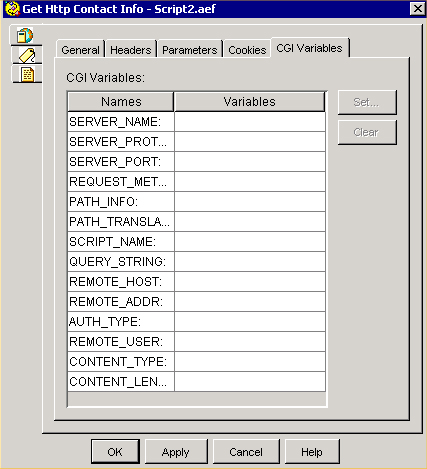CGI Variables tab (Get Http Contact Info step)
Use the CGI (Common Gateway Interface) Variables tab of the Get Http Contact Info customizer window to map information from CGI environment variables to local variables.

The following table describes the properties of the Environment tab of the Get Http Contact Info customizer window:
|
Properties / Buttons |
Description |
|---|---|
|
Name / Variable |
The names of CGI Environment variables and corresponding local variables to which they are mapped. See Http Contact Environment Variables table for descriptions of each of the Environment variables. |
|
Set (button) |
To set a variable, select a Name and click Set. Choose a value from the Variable drop-down list and then click OK; the variable name appears in the Variable column next to the Name you selected. |
|
Delete (button) |
To remove Environment information, highlight a value in the list and click Delete. |
The following table describes each Environment variable:
|
Name |
Description |
|---|---|
|
AUTH_TYPE |
The protocol-specific authentication method used to validate the user when the server supports user authentication and the script requires authentication. |
|
CONTENT_LENGTH |
The content length of the data as specified by the client. |
|
CONTENT_TYPE |
The content type of the data for queries such as HTTP GET and HTTP POST that have attached information. |
|
PATH_INFO |
Extra path information as given by the client. Scripts can be accessed by a virtual pathname, followed by extra information at the end of the path. The extra information is sent as PATH_INFO. The server decodes this information if it comes from a URL before it is passed to the script. |
|
PATH_TRANSLATED |
Translated version of PATH_INFO, with any associated virtual-to-physical mapping. |
|
QUERY_STRING |
The information that follows the question mark (?) in the URL that references this script. This information is the query information. Do not decode it. Always set this variable when there is query information, regardless of command line decoding. |
|
REMOTE_ADDR |
The IP address of the remote host making the request. |
|
PREMOTE_HOST |
The hostname making the request. If the server does not have this information, it will instead set REMOTE_ADDR. |
|
REMOTE_USER |
The authenticated user name when the server supports user authentication and the script requires authentication. |
|
REQUEST_METHOD |
The method of the request that was made, such as GET or POST. |
|
SCRIPT_NAME |
A virtual path to the script being executed, used for self-referencing URLs. |
|
SERVER_NAME |
The server’s hostname, (Domain Name Service) DNS alias, or IP address as it would appear in a self-referencing URL. |
|
SERVER_PORT |
The TCP port number of the request. |
|
SERVER_PROTOCOL |
The name and revision of the information protocol of the request, in the format: protocol/revision. |